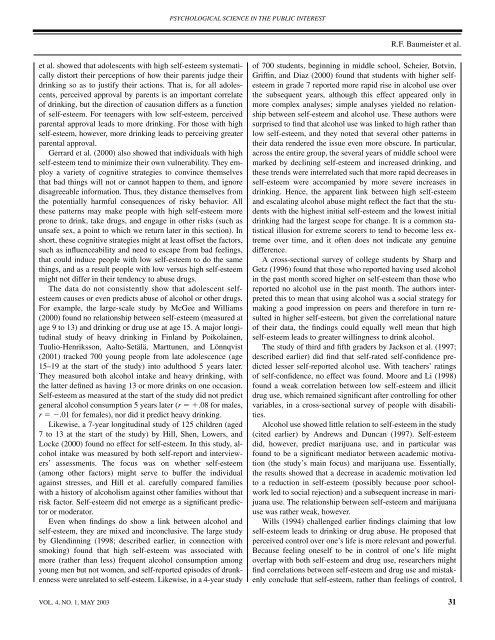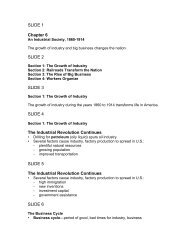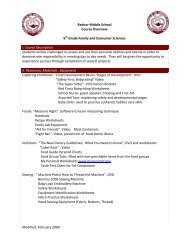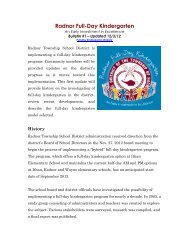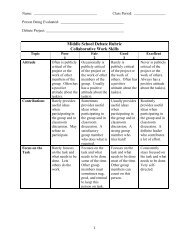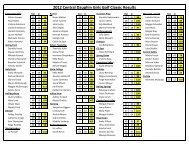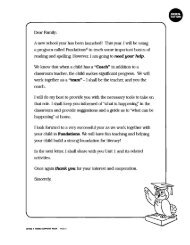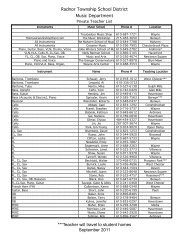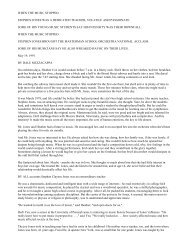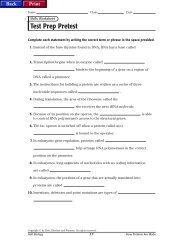Self-Esteem and Student Achievement
Self-Esteem and Student Achievement
Self-Esteem and Student Achievement
You also want an ePaper? Increase the reach of your titles
YUMPU automatically turns print PDFs into web optimized ePapers that Google loves.
PSYCHOLOGICAL SCIENCE IN THE PUBLIC INTERESTR.F. Baumeister et al.et al. showed that adolescents with high self-esteem systematicallydistort their perceptions of how their parents judge theirdrinking so as to justify their actions. That is, for all adolescents,perceived approval by parents is an important correlateof drinking, but the direction of causation differs as a functionof self-esteem. For teenagers with low self-esteem, perceivedparental approval leads to more drinking. For those with highself-esteem, however, more drinking leads to perceiving greaterparental approval.Gerrard et al. (2000) also showed that individuals with highself-esteem tend to minimize their own vulnerability. They employa variety of cognitive strategies to convince themselvesthat bad things will not or cannot happen to them, <strong>and</strong> ignoredisagreeable information. Thus, they distance themselves fromthe potentially harmful consequences of risky behavior. Allthese patterns may make people with high self-esteem moreprone to drink, take drugs, <strong>and</strong> engage in other risks (such asunsafe sex, a point to which we return later in this section). Inshort, these cognitive strategies might at least offset the factors,such as influenceability <strong>and</strong> need to escape from bad feelings,that could induce people with low self-esteem to do the samethings, <strong>and</strong> as a result people with low versus high self-esteemmight not differ in their tendency to abuse drugs.The data do not consistently show that adolescent selfesteemcauses or even predicts abuse of alcohol or other drugs.For example, the large-scale study by McGee <strong>and</strong> Williams(2000) found no relationship between self-esteem (measured atage 9 to 13) <strong>and</strong> drinking or drug use at age 15. A major longitudinalstudy of heavy drinking in Finl<strong>and</strong> by Poikolainen,Tuulio-Henriksson, Aalto-Setälä, Marttunen, <strong>and</strong> Lönnqvist(2001) tracked 700 young people from late adolescence (age15–19 at the start of the study) into adulthood 5 years later.They measured both alcohol intake <strong>and</strong> heavy drinking, withthe latter defined as having 13 or more drinks on one occasion.<strong>Self</strong>-esteem as measured at the start of the study did not predictgeneral alcohol consumption 5 years later (r .08 for males,r .01 for females), nor did it predict heavy drinking.Likewise, a 7-year longitudinal study of 125 children (aged7 to 13 at the start of the study) by Hill, Shen, Lowers, <strong>and</strong>Locke (2000) found no effect for self-esteem. In this study, alcoholintake was measured by both self-report <strong>and</strong> interviewers’assessments. The focus was on whether self-esteem(among other factors) might serve to buffer the individualagainst stresses, <strong>and</strong> Hill et al. carefully compared familieswith a history of alcoholism against other families without thatrisk factor. <strong>Self</strong>-esteem did not emerge as a significant predictoror moderator.Even when findings do show a link between alcohol <strong>and</strong>self-esteem, they are mixed <strong>and</strong> inconclusive. The large studyby Glendinning (1998; described earlier, in connection withsmoking) found that high self-esteem was associated withmore (rather than less) frequent alcohol consumption amongyoung men but not women, <strong>and</strong> self-reported episodes of drunkennesswere unrelated to self-esteem. Likewise, in a 4-year studyof 700 students, beginning in middle school, Scheier, Botvin,Griffin, <strong>and</strong> Diaz (2000) found that students with higher selfesteemin grade 7 reported more rapid rise in alcohol use overthe subsequent years, although this effect appeared only inmore complex analyses; simple analyses yielded no relationshipbetween self-esteem <strong>and</strong> alcohol use. These authors weresurprised to find that alcohol use was linked to high rather thanlow self-esteem, <strong>and</strong> they noted that several other patterns intheir data rendered the issue even more obscure. In particular,across the entire group, the several years of middle school weremarked by declining self-esteem <strong>and</strong> increased drinking, <strong>and</strong>these trends were interrelated such that more rapid decreases inself-esteem were accompanied by more severe increases indrinking. Hence, the apparent link between high self-esteem<strong>and</strong> escalating alcohol abuse might reflect the fact that the studentswith the highest initial self-esteem <strong>and</strong> the lowest initialdrinking had the largest scope for change. It is a common statisticalillusion for extreme scorers to tend to become less extremeover time, <strong>and</strong> it often does not indicate any genuinedifference.A cross-sectional survey of college students by Sharp <strong>and</strong>Getz (1996) found that those who reported having used alcoholin the past month scored higher on self-esteem than those whoreported no alcohol use in the past month. The authors interpretedthis to mean that using alcohol was a social strategy formaking a good impression on peers <strong>and</strong> therefore in turn resultedin higher self-esteem, but given the correlational natureof their data, the findings could equally well mean that highself-esteem leads to greater willingness to drink alcohol.The study of third <strong>and</strong> fifth graders by Jackson et al. (1997;described earlier) did find that self-rated self-confidence predictedlesser self-reported alcohol use. With teachers’ ratingsof self-confidence, no effect was found. Moore <strong>and</strong> Li (1998)found a weak correlation between low self-esteem <strong>and</strong> illicitdrug use, which remained significant after controlling for othervariables, in a cross-sectional survey of people with disabilities.Alcohol use showed little relation to self-esteem in the study(cited earlier) by Andrews <strong>and</strong> Duncan (1997). <strong>Self</strong>-esteemdid, however, predict marijuana use, <strong>and</strong> in particular wasfound to be a significant mediator between academic motivation(the study’s main focus) <strong>and</strong> marijuana use. Essentially,the results showed that a decrease in academic motivation ledto a reduction in self-esteem (possibly because poor schoolworkled to social rejection) <strong>and</strong> a subsequent increase in marijuanause. The relationship between self-esteem <strong>and</strong> marijuanause was rather weak, however.Wills (1994) challenged earlier findings claiming that lowself-esteem leads to drinking or drug abuse. He proposed thatperceived control over one’s life is more relevant <strong>and</strong> powerful.Because feeling oneself to be in control of one’s life mightoverlap with both self-esteem <strong>and</strong> drug use, researchers mightfind correlations between self-esteem <strong>and</strong> drug use <strong>and</strong> mistakenlyconclude that self-esteem, rather than feelings of control,VOL. 4, NO. 1, MAY 2003 31


